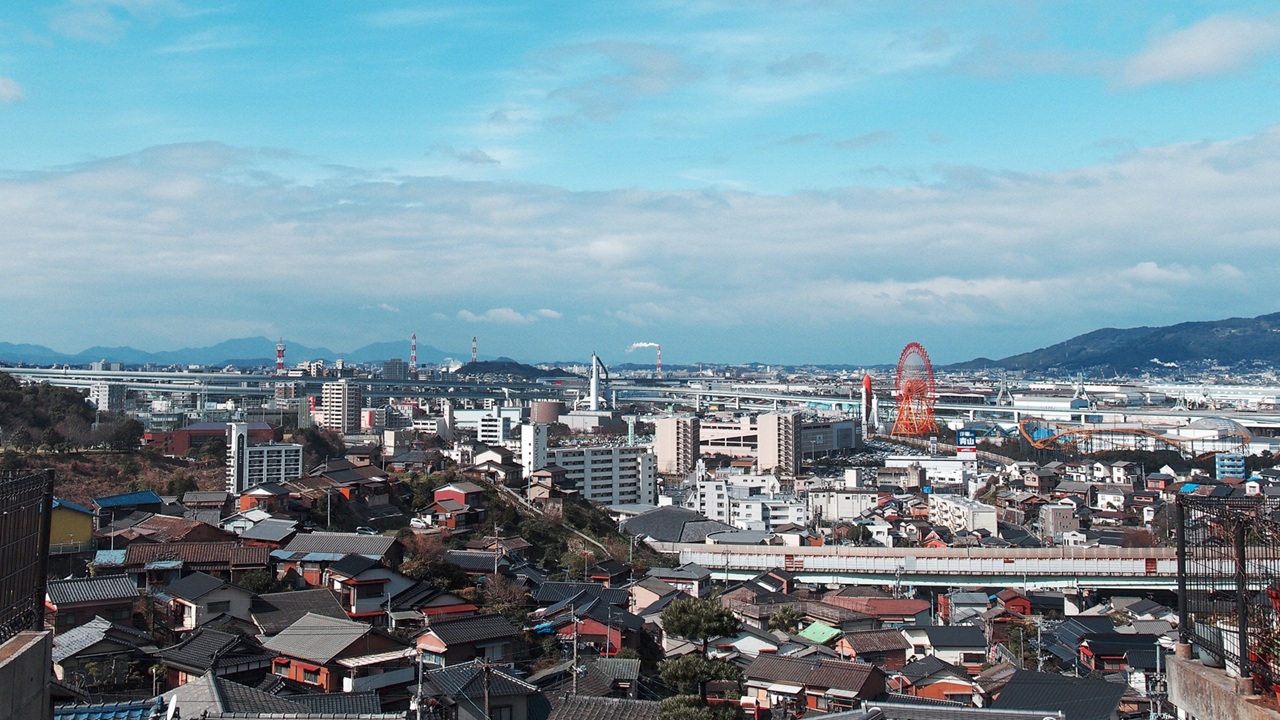
What happens to manufacturing cities after their core industries vanish?
Several economic crises have devastated old industrial cities since their heydays in the early twentieth century. Starting in the 1950s, the giants that had fueled economic development up to that point underwent severe decline, with massive job losses and economic hardship, often leading to population shrinkage.
Places such as Detroit and Pittsburgh in the United States, Liverpool and Manchester in the United Kingdom, the Ruhr region in Germany, and Hakodate and Kitakyushu in Japan saw their livelihoods dwindle as factories, mills, and warehouses shut down one after another. These (and countless other) cities had to reinvent themselves, finding alternative sources of economic activity away from manufacturing. Most invested in research and innovation, diversified into technology and healthcare, and implemented social inclusion initiatives to heal the scars of deindustrialization.
Kitakyushu City, Japan, took a different path. Rather than distancing itself from manufacturing, the city leaned into its industrial know-how and history of pollution abatement to build a green economy.
Kitakyushu’s transformation did not happen overnight. It unfolded over decades, shaped by environmental crises, grassroots actions, and local leaders’ willingness to rethink what economic development means. This transition was driven by the most unexpected actors: a group of housewives with a vision for cleaner air and bluer skies.
The City that Built Modern Japan
In less than five decades, Kitakyushu transformed itself from a small, impoverished fishing village—formerly known as Yawata—into the steel capital of Japan. Located at the northernmost tip of Kyushu, the country’s third largest island, Yawata’s distance from Tokyo—both politically and geographically—made it seem an unlikely place for Japan to stake its industrial future. Why Yawata? And why then?
Seeking rapid industrialization, the government of Japan decided to open a state-run iron and steel mill in the 1890s. Even though Yawata had no significant industrial and urban development at that time, its proximity to coal, water, and established transport routes provided key geographical and logistical advantages. To begin with, it was close to the castle town of Kokura, a key regional economic and administrative hub. It was also close to Moji, at the time emerging as a crucial international trading port. And more importantly, it was close to the Chikuho coalfield, Japan’s largest coal field before World War II. These advantages tipped the scales in Yawata’s favor, starting the transformation of Northern Kyushu into a buoyant industrial region.
Yawata Steelworks opened in 1901. Ever since, the mill and the city developed a symbiotic relationship. The need for workers pulled people from all over Kyushu. Yawata’s population exploded, jumping from some 6,000 residents in 1901 to more than 100,000 in 1920. Other heavy industries followed soon after in surrounding towns, giving birth to a highly industrialized and well-integrated industrial region. Air raids during World War II inflicted great damage to housing, infrastructure, and factories. The city rebuilt itself, once again upon the shoulders of iron and steel throughout the 1950s.
During the post-war period, the constant smoke rising from factory chimneys became a symbol of progress and recovery. Locals called it the “smoke of seven colors,” echoing a rainbow that represents growing prosperity and national pride. It was seen as a sign that Japan’s recovery was underway. But behind the colorful haze, the price of progress was becoming clear: rapid reindustrialization was destroying Kitakyushu’s air, rivers, and sea.
Women’s Associations Fight for a Cleaner Environment
Kitakyushu was an industrial powerhouse and a national success story. But its success was harming its people. When the smoke turned from a rainbow to a health hazard, women began fighting for a different future.
Industrial pollution was causing health problems, especially in children and the elderly. Despite persistent traditional gender roles, the Allied Occupation forces granted women new rights, encouraging the formation of women’s associations to foster political education, civic participation, and advocacy for women’s rights. The establishment of the Tobata Women’s Association in 1950 kickstarted a movement to restore the sky to its blue color.
Tobata Women’s Association began by conducting research to demonstrate the connection between pollution and health hazards. They hung white shirts on the rooftops of public schools to observe changes in color after a few days and placed milk cartons and cans to measure soot and ashfall. They then compared the shirts’ discoloration and soot collected in relation to their distance from factories. To validate their findings, women’s associations also partnered with university researchers and published their results.
Their research created a platform to lobby local officials for change. Their first victory came in 1952, when local authorities mediated to compel a power station to install smokestack cleaners. This first step toward a cleaner environment encouraged further action from other women’s associations.
The high point of their fight for environmental justice came in 1965 with the publication of the “We Want Blue Skies” report. Authored by 13 women’s associations in Kitakyushu and representing more than 6,000 members, the report summarized data collected from 1961 and 1964 on the pollutants plaguing the city. They also produced an independent documentary that aired on national television that year, raising awareness of the human cost of pursuing economic development at any price.
The determination of these women’s associations drew politicians into the story. Their movement influenced policymaking from the bottom up. They lobbied politicians and private companies to strengthen antipollution measures, reaching settlements through mediation by Kitakyushu City. Their actions laid the groundwork for a broader shift where environmental restoration became a pillar of Kitakyushu’s future.
Galvanized by public pressure, city leaders began to act: not simply to reduce pollution, but to reimagine Kitakyushu’s future.
Becoming a Green City
The “We Want Blue Skies” campaign coincided with Kitakyushu’s reckoning with its economic model. The city’s heavy industries were destroying its environment while also beginning to stagnate. Growing international competition and the gradual concentration of production in Tokyo weakened Kitakyushu’s industrial base.
From the late 1960s, Japan’s industrial geography shifted toward the Tokyo region, whose factories expanded often at the expense of older sites in more remote areas. Yawata Steelworks was progressively downgraded, losing its research and development functions and shedding workers who were reassigned to other plants. The merger of Yawata Iron & Steel and Fuji Iron & Steel to form Nippon Steel Corporation further consolidated operations in and around Tokyo.
The local officials soon grasped the magnitude of the challenge ahead of them. They were facing not only the legacy of unchecked industrialization and widespread pollution, but also the collapse of the city’s primary industry—and employer. For decades, the local economy had revolved around Yawata Steelworks, either directly or through its supply chain. As the mill declined, so did Kitakyushu. Outmigration followed, driven by vanishing job opportunities and harsh environmental conditions. The city’s population peaked at 1,065,078 in 1980 and had fallen to 902,358 by 2025.
In the 1970s, local authorities joined forces with private companies to restore Kitakyushu’s natural environment. As local companies developed innovative solutions to meet stricter national and local standards, they gained expertise in pollution control and environmental remediation. City leaders soon recognized that this emerging environmental know-how offered a pathway to diversify Kitakyushu’s economic base. Rather than chasing service industries—the common tactic deployed by other deindustrializing cities—Kitakyushu chose to promote new industrial sectors centered on sustainable development, including waste management and recycling.
This approach bridged the city’s manufacturing past with its hard-won experience cleaning up its environment, aligning Kitakyushu’s industrial future with the urgent need to build more sustainable and resilient cities.
In seeking to usher in a new era, local authorities looked to Pittsburgh, Pennsylvania, USA, for inspiration. Pittsburgh had followed a similar development trajectory to Kitakyushu. Like Kitakyushu, the steel-built city had suffered severe environmental degradation. But Pittsburgh’s renaissance plan, launched in the late 1940s, had addressed both economic and environmental challenges. After a field visit to Pittsburgh, Kitakyushu approved its own “Renaissance Masterplan” in 1988, leveraging its industrial past to pave the way for a future centered on green industries.
To solidify its green turn, Kitakyushu joined several prefectural and national programs supporting green economic development. As a first step, and framed within the Renaissance Masterplan, the city established the Kitakyushu Techno Park and the Techno-Center in 1990, to support the transition of its manufacturing from heavy to high-tech industries.
In 1997, Kitakyushu joined a national initiative promoting the creation of “eco-towns.” The eco-town program encapsulated Kitakyushu’s new ethos by promoting local economic development through environment-related enterprises. Kitakyushu’s eco-town became the cornerstone of the city’s green growth revitalization efforts. It combined research and development, manufacturing, and commercialization capabilities in a single location to support green businesses. The eco-town promoted value-added activities, opening new avenues for growth for existing and new businesses alike.
Ever since, Kitakyushu has replicated this model to advance its green economy, joining different national programs—gaining recognition and, in some cases, funding—to advance local sustainable development. Initiatives such as the Eco-model City in 2008, the FutureCity Initiative in 2011, and the SDGs Future City Initiative in 2018 built upon existing efforts to expand the city’s green industrial capacity. These strategies were export-oriented, aimed at internationalizing Kitakyushu’s economy and opening new markets for its companies.
Decades after the smoke of seven colors and the women’s associations’ fight for a cleaner environment, Kitakyushu had managed to turn its environmental crisis into the foundation for a new kind of prosperity.
Lessons Learned and Future Challenges
Kitakyushu’s transformation from steel to green industries was a steady, layered process. Following the destruction of its natural environment during the years of rapid post-war reindustrialization and the associated health hazards, women’s associations fought to claim back the sky’s blue color. Facing economic decline and environmental collapse, city leaders recognized the potential in their pollution control expertise. Unlike other cities that sought advanced service industries and complete rebranding, Kitakyushu restructured from within, anchoring their revitalization policies in grassroots action and its industrial heritage.
Rather than abandoning its manufacturing identity, Kitakyushu redefined it. Amid the growing national and global competition to attract knowledge-based industries, the city looked to its distinct advantages: deep manufacturing expertise and environmental cleanup know-how.
What can other cities facing deindustrialization learn from Kitakyushu?
1. Build on existing strengths rather than discarding them entirely.
Kitakyushu reimagined its industrial capabilities for emerging green sectors instead of abandoning manufacturing altogether.
2. Transform crises into competitive advantages.
Environmental pollution became the catalyst for developing cleanup knowledge, turning past problems into the foundation for future economic opportunities.
3. Embrace grassroots movements as policy drivers.
Women’s associations provided the research and pressure that legitimized major policy shifts, creating space for bold economic transformation.
While Kitakyushu still faces population decline, its experience demonstrates that cities need not conform to pre-established development models. By drawing on their unique history, listening to local voices, leveraging existing capabilities, and maintaining long-term vision, cities can transform their greatest challenges into distinctive pathways forward.

FERNANDO ORTIZ-MOYA, PhD, is a chief policy researcher at the Institute for Global Environmental Strategies in Japan.
New, Reduced Membership Dues
A new, reduced dues rate is available for CAOs/ACAOs, along with additional discounts for those in smaller communities, has been implemented. Learn more and be sure to join or renew today!
